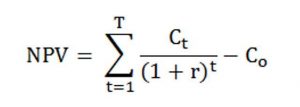
Net Present Value (NPV)


Related Articles
-
Sharpe Ratio
In order to be sound in your financial goals, you need to have a great source of knowledge on every... Read more
-
Asset Coverage Ratio
This article covers the far-reaching topic of the asset coverage ratio. We’re talking about a risk measurement whose aim is... Read more
-
Return on Assets
The return on total assets can show if the managing team is effective at earning money from the company’s assets... Read more
-
Retention Ratio
The retention ratio or plow back ratio is the calculation that shows you exactly what percentage of your net income... Read more


